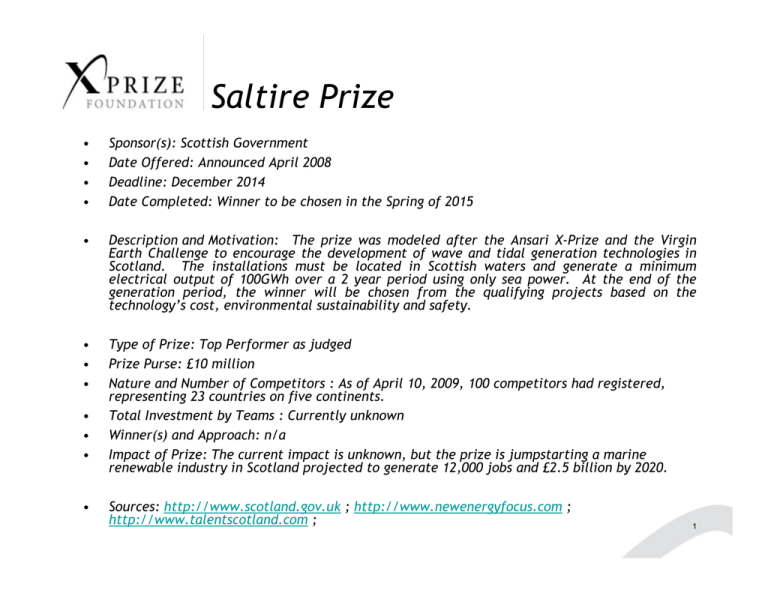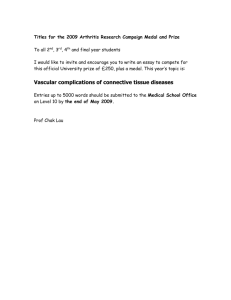Saltire Prize
advertisement

Saltire Prize • • • • Sponsor(s): Scottish Government Date Offered: Announced April 2008 Deadline: December 2014 Date Completed: Winner to be chosen in the Spring of 2015 • Description and Motivation: The prize was modeled after the Ansari X-Prize and the Virgin Earth Challenge to encourage the development of wave and tidal generation technologies in Scotland. The installations must be located in Scottish waters and generate a minimum electrical output of 100GWh over a 2 year period using only sea power. At the end of the generation period, the winner will be chosen from the qualifying projects based on the technology’s cost, environmental sustainability and safety. • • • Type of Prize: Top Performer as judged Prize Purse: £10 million Nature and Number of Competitors : As of April 10, 2009, 100 competitors had registered, representing 23 countries on five continents. Total Investment by Teams : Currently unknown Winner(s) and Approach: n/a Impact of Prize: The current impact is unknown, but the prize is jumpstarting a marine renewable industry in Scotland projected to generate 12,000 jobs and £2.5 billion by 2020. • • • • Sources: http://www.scotland.gov.uk ; http://www.newenergyfocus.com ; http://www.talentscotland.com ; 1 H-Prize • • • • • • • • • • Sponsor: Office of Energy Efficiency and Renewable Energy, Department of Energy (DOE) Date Offered: February 15, 2010 (Registration) Deadline: Dec 2010/Jan 2011 Sample testing; Date Completed: February 2011 - Award Description and Motivation: To be awarded for demonstrated advancements in the development of an on-board hydrogen storage material for light-duty vehicles. Type of Prize: Community-based Incentive Prize Purse(s): Single award of US$ 1 million Nature and Number of Competitors: unknown Total Investment by Teams: unknown Winner(s) and Approach: Meeting the following criteria of Hydrogen Storage Material breakthrough: – – – – – – • • Material with potential of hydrogen rechargeable material More than 7.5 weight percent gravimetric capacity More than 70 g/liter releasable volumetric capacity More than 4x10-4 g of hydrogen charging kinetics More than 2x10-5 g of hydrogen discharge kinetics Life cycle of 100 Impact of Prize: Stimulate the development of new materials and techniques capable to store hydrogen in vehicles and brake the critical barriers for vehicles fueled with hydrogen to penetrate in the market. Sources: www.hydrogenprize.org 2 Beal Conjecture and Prize • • • • • • • • • • • Sponsor: Andrew Beal Date Offered: December 1997 Deadline (if known): none Date Completed: active Description and Motivation: This prize is for the proof or disproof of the following number theoretic conjecture: If ax + by = cz, where a, b, c, x, y and z are positive integers and x, y and z are all greater than 2, then a, b and c must have a common prime factor. The sponsor has computationally confirmed the validity of the conjecture for small integers. The conjecture is a generalization of the Fermat’s Last Theorem (for which the Wolfskehl Prize was given), and the sponsor believes that Fermat possessed a relatively simple non-geometry-based proof for his theorem. He hopes to spur related number theoretic advances by posing a generalization of the problem. Type of Prize: First to Achieve Prize Purse: $100,000 (USD) Nature and Number of Competitors (if known): There is no registration procedure and the prize is given after a proof appears in a reputable refereed journal or a counterexample has been given and verified. The nature and number of competitors is therefore unknown. Total Investment by Teams (if known): unknown Winner(s) and Approach: The prize is still active and has no fixed deadline Impact of Prize: The prize seems to have had little impact on the mathematical community. Sources: R. Daniel Mauldin, “A Generalization of Fermat’s Last Theorem: The Beal Conjecture and Prize Problem,” Not. AMS, vol. 44, no. 11, pp. 1436–1437, Dec. 1997.; http://www.bealconjecture.com/; http://www.math.unt.edu/~mauldin/beal.html 3 Volta Prize • • • • • Sponsor(s): French Government (Founded by Napoleon Bonaparte) Date Offered: Established in 1803 to honor Alessandro Volta Deadline (if known): continuing (annual) Date Completed: N/A Description and Motivation: In 1801, Alessandro Volta was summoned to Paris to present his invention of the Voltaic Pile (the first electric battery). His presentation impressed Napoleon so much, he awarded him a gold medal, made him a count, and founded the annual Volta Prize in his honor. The Volta Prize is awarded each year for scientific discoveries in electricity. Perhaps the most notable recipient was Alexander Bell, who was awarded a Volta Prize of US$10,000 in 1880 for his invention of the telephone. • • • • • Type of Prize: Top performer / Recognition Prize Purse(s): Varies Nature and Number of Competitors (if known): Unknown – Ongoing Total Investment by Teams (if known): Unknown Winner(s) and Approach: Founded in honor of Alessandro Volta for the invention of the electric battery. Most Notable: Awarded to Alexander Bell for the invention of the telephone. Impact of Prize: Various, although this prize is more of a recognition prize and therefore is not directly responsible for incentivizing social / technological impact. Bell did use his winnings to establish institutions and laboratories around Washington, D.C., which have had far-reaching benefits. Main impact has been to spur ongoing entrepreneurship in electricity research. Sources: • • – – – http://web.fccj.org/~ethall/electro/electro.htm http://en.wikipedia.org/wiki/Volta_Prize http://www.thocp.net/biographies/volta_alessandro.htm 4 MIT OpenCourseWare http://ocw.mit.edu ESD.172J / EC.421J X PRIZE Workshop: Grand Challenges in Energy Fall 2009 For information about citing these materials or our Terms of Use, visit: http://ocw.mit.edu/terms.


